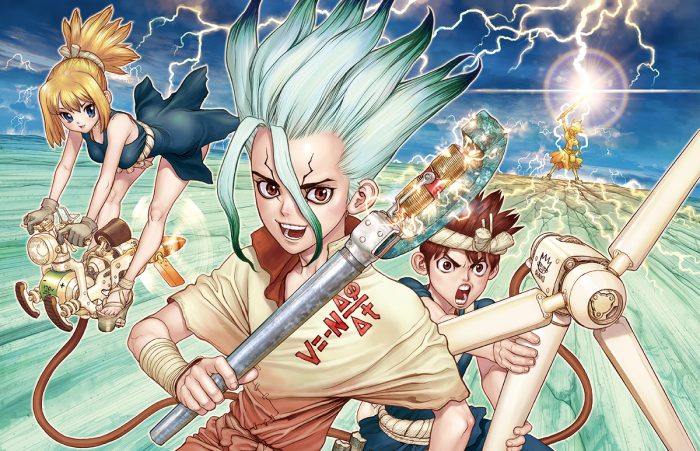
Dr. Stone is the newest in a line of Weekly Shounen Jump series that takes the general structure and tropes of a battle shounen (a la Dragon Ball Z or Naruto) and applies them to something new. Shokugeki no Souma does this with food, Boku no Hero Academia does it with Western superheroes, and Dr. Stone is all about science. There are no superpowers or magic spells in the new Stone Age—only cold, hard scientific truths will help our heroes succeed in their mission to rebuild society from the ground up.
But how realistic is the science in this series? If real people were in Senku and company’s situation, would they be able to use the same methods to survive and thrive in a world that’s been untouched by humans for 3700 years? And, if not, does it really matter in the grand scheme of things? Let’s dig deeper into the scientific accuracy of Dr. Stone!
They Did the Research
Just as Shokugeki no Souma has a chef consultant on hand to develop recipes, Dr. Stone mangaka Riichiro Inagaki has a scientist consultant named Kurare on speed dial for whenever he needs extra help understanding a particular subject. He does mountains of research on his own, including taking glassblowing classes to better portray how Kaseki the craftsman works with glass, but asks for further explanation from the consultant when needed (such as when he tried to wrap his brain around how putting a tube inside another tube could create radio waves).
The artist, Boichi, also takes great care in accurately portraying Senku’s inventions and the different cultural aspects of the stone world. He made sure that the rockets Senku built as a child were of a complexity that he could realistically achieve at his age, that the stone tools he built on his own were different than those of the villagers, that the far future Japan feels like a logical evolution of the modern one, and so many more small details that most readers wouldn’t even notice. But if all of those details had been overlooked, the world of Dr. Stone wouldn’t feel so vibrant and real.
Lighthearted at Its Core
All of that said, there are a few gaping holes in the world’s logic that are difficult to ignore. Why didn’t Senku and Taiju go insane from thinking in solitude for 3720 straight years? How can the stone world villagers communicate with the modern characters when their language should’ve evolved into something incomprehensible over thousands of years? With the exception of one throwaway line from Yuzuriha, why do none of the depetrified characters worry about their parents and loved ones? Would all of these inventions really work so flawlessly with rudimentary materials like bamboo?
In a recent interview with Viz, Inagaki jokingly brushed off these types of questions by saying, “If nobody really knows for sure [what would happen], then the god of the world can decide it. And I’m the god of the world in Dr. Stone.” Essentially, we can take this to mean that Dr. Stone isn’t the type of story that goes for a completely accurate depiction of a post-apocalyptic world. The tone would get very dark very quickly if Inagaki showed people losing their minds or grieving over their families, so those aspects are ignored in favor of focusing on the inventions and culture, which young readers would be interested in learning about. Whether or not this approach works is up to the individual reader to decide, but we think that it was a good decision in this case.
An Inspiration to Young Scientists
It’s an eternal struggle for educators and scientists the world over—what’s the best way to get kids excited about the STEM fields? Well, whether Inagaki intended it or not, Dr. Stone’s incredible popularity has made it into the perfect platform for spreading the joy of science to a younger generation. Readers can learn how radio transmissions work, how to survive in the wilderness, how natural resources can be used to make gunpowder (although the manga clearly warns against replicating that experiment at home), and more just by keeping up with Dr. Stone’s chapters week by week. And since it’s framed as a fun, video-game-like adventure, there’s no reason not to give these ideas a try!
Realistically, some of Senku’s inventions like the nitric acid fluid would be too imprecise, weak, or unreliable to work perfectly with the resources available in the stone world. But in real life, an aspiring young scientist can take inspiration from his efforts and create an experiment of their very own!
Final Thoughts

Overall, Dr. Stone is scientifically accurate where it counts. Elements that would stall the plot or make the story too dark are left out, while scientific experiments are portrayed with as much accuracy as can be expected for a character who’s limited to Stone Age technology. If it’s entertaining and inspires kids to give science a shot, that’s what really matters!
What did you think of our overview? Do you think realism and scientific accuracy is vital to Dr. Stone’s story? Let us know in the comments, and thanks so much for reading!
Recommended Post
Dr. STONE Announces New OP & ED!
Recommended Post



